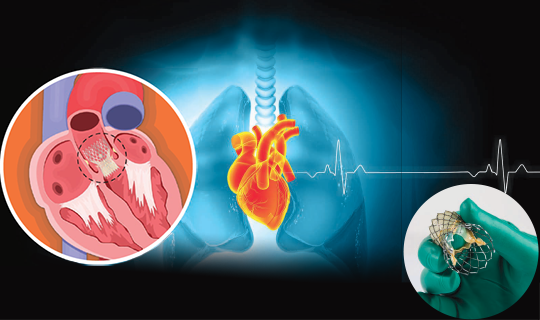
Minimally invasive therapies are easier on patients — and have lasting benefits.
The heart is a remarkable, durable organ, beating thousands of times a day for years on end. But eventually many people develop problems in the hardworking structures of the heart, especially its four valves — the aortic, mitral, tricuspid and pulmonic.

For example, about one in 14 people develops an especially common structural heart condition called aortic stenosis, in which the relatively large aortic valve thickens and stiffens, impairing the heart’s ability to pump enough blood to the body.
In the past, replacing — or in some cases, repairing — defective valves required open heart surgery, a well-established, highly reliable procedure with low complication rates. In recent years, however, increasing numbers of heart patients have benefited from minimally invasive heart procedures that don’t require open heart surgery.
“At RWJBarnabas Health [RWJBH], we’re at the forefront of minimally invasive valvular therapies that are completely transforming treatment,” says Mark Russo, MD, Chief of Cardiovascular and Thoracic Surgery and Director of Structural Heart Disease, Robert Wood Johnson University Hospital in New Brunswick; Professor of Surgery and Chief of Cardiac Surgery, Rutgers Robert Wood Johnson Medical School; and a member of RWJBarnabas Health Medical Group.
A Cardiology Revolution
While open heart surgery often remains the best option for some people with valve disorders, minimally invasive valve procedures offer a number of advantages for patients who are good candidates for the treatments. Among the benefits are:
- Smaller incisions. Therapies such as transcatheter aortic valve replacement (TAVR) — one of the most common and well-established minimally invasive heart valve procedures — entail inserting a catheter (a thin, flexible tube) into a blood vessel, usually in the groin. After threading it to the heart, surgeons use the catheter to install a replacement valve inside the patient’s original valve. This approach eliminates the need to open the chest and access the heart through a large incision.
- No heart-lung machine. Avoiding open heart surgery means the minimally invasive surgical team doesn’t need to stop a patient’s heart during the procedure, and the patient doesn’t need to go on a heart-lung machine to keep blood and oxygen flowing to the body.
- Shorter hospital stays. An open heart surgery typically takes about 2½ hours, while a TAVR procedure takes about 30 minutes to an hour. After surgery, open-heart patients generally spend three to seven days in the hospital, including time in the intensive care unit, while most TAVR patients go home the day after surgery.
- No general anesthesia. While the complexities of open heart surgery require general anesthesia, TAVR patients only need to be sedated.
- Faster recovery. “It’s a reflection of the expertise we have at RWJBH that we have helped develop these less invasive therapies that allow excellent outcomes with a faster recovery and return to normal function,” Dr. Russo says.
Dr. Russo contributed to a recent study published in The New England Journal of Medicine that shows no difference in outcomes between TAVR and traditional open heart surgery after five years. Such research is important because it demonstrates that results of minimally invasive surgeries like TAVR stand up well over time.
“These procedures not only are less invasive than open heart surgery but also are increasingly shown to produce outcomes that are just as good as— or better than—those of traditional operations,” Dr. Russo says.
Are You a Candidate?
The first signs of structural heart problems like aortic stenosis are often subtle. “Fatigue and shortness of breath are most common,” Dr. Russo says. “Often they develop slowly, and people dismiss them as just a sign that they’re getting older.”
But these symptoms become progressively worse, often accompanied by additional problems such as chest pain and lightheadedness. Valve disorders can quickly turn severe, increasing the risk of heart failure. Diagnosis often occurs when a doctor detects a heart murmur during a routine checkup and advises follow-up testing such as a telltale echocardiogram.
When stenosis or other valve problems are found, a multidisciplinary team evaluates each patient’s options.
“Multidisciplinary” means that team members have different backgrounds, including surgical, medical, interventional, imaging and anesthesia. Each person on the team brings a different perspective, allowing a well-rounded consensus about the best pathway for treatment.
As research continues to confirm the quality and durability of outcomes from minimally invasive heart procedures, most patients are now considered at least potential candidates for these innovative treatments. TAVR and other minimally invasive heart valve procedures are especially common in patients over 65.
And treatments continue to evolve. For example, Dr. Russo and his team are now using an investigational minimally invasive device called the JenaValve for patients with regurgitation, or leakage, in the aortic valve.
“Our making this available as part of a clinical trial is an example of our expertise and capabilities,” Dr. Russo says. “We’re leaders in minimally invasive therapies and have access to technologies not available at other centers anywhere in the state. Patients can receive innovative treatments that improve outcomes while staying close to home.”
To learn more about surgical and transcatheter aortic valve replacement, visit our TAVR page.
Whoever your heart beats for, our hearts beat for you. To connect with a top cardiovascular specialist at RWJBarnabas Health, call 888-724-7123 or request an appointment.
 View full issues of Healthy Together magazine by New Jersey region:
View full issues of Healthy Together magazine by New Jersey region: